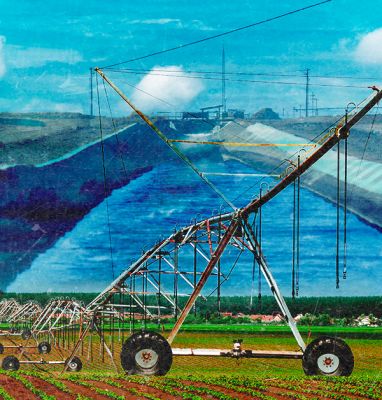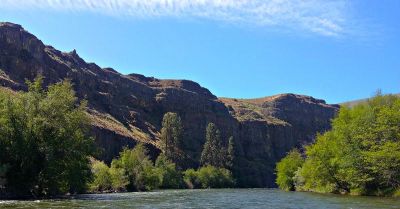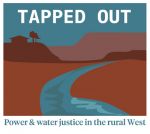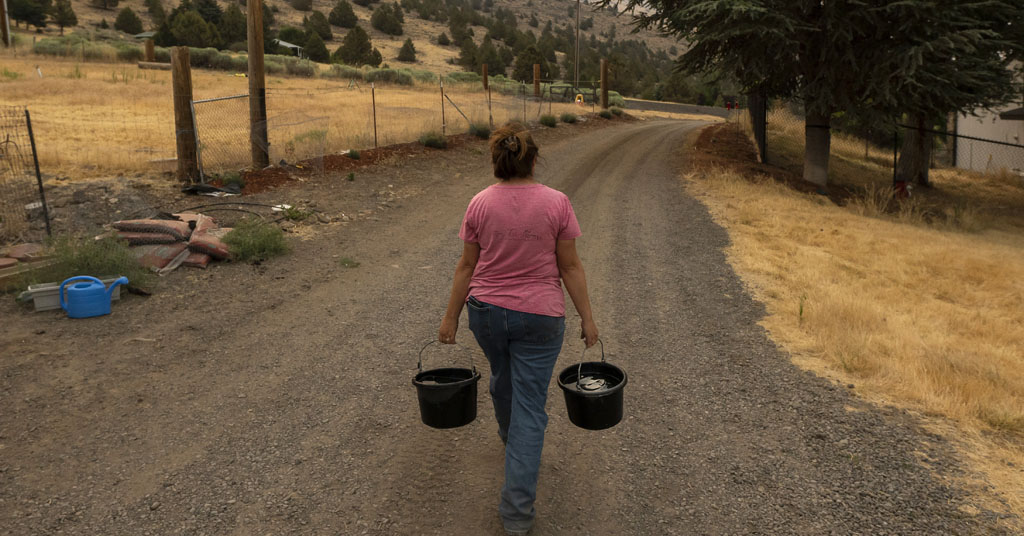With farms, ranches and rural communities facing historic drought, a worrying trend leads to a critical question: Who owns the water?

Story by Eli Francovich. Photo illustrations by Nicole Wilkinson. December 6, 2021. Ghost cattle—200,000 made-up heifers. A massive fraud rocking eastern Washington’s arid ranching communities, leading to criminal charges and bankruptcy. The Church of Jesus Christ of Latter-day Saints and a Bill Gates-owned company duking it out at the auction block, each willing to spend more than $200 million to buy 22,500 acres of ranch land and its associated water rights.
These were just some of the headlines from this past summer when Cody Easterday of Mesa, Wash., plead guilty to defrauding Tyson Foods and another unnamed company of more than $244 million. He did so, according to court documents, by billing for the care of those imaginary animals.
After he pleaded guilty, the bidding war on his land started. In June, the Church’s agricultural holding company beat out Gates’ 100C LLC, cementing the Latter-day Saints as one of the largest commercial agricultural landowners in the western United States.
That’s raised troubling questions about land consolidation, a decades-long trend fueled by the demise of the family farm. But there’s a more complicated, and potentially troubling consequence to that purchase.
The water.
MORE TAPPED OUT: Where is the water going? Small farmers struggle as ag titans wheel water for profit
As western lands are consolidated, so too are the rights to use the water that flows under and over those lands. As the Pacific Northwest gets warmer and drier, water is becoming a hot commodity that’s attracting investors—whether it’s the Latter-day Saints, large agricultural interests or New York investors.
And while state laws across the region regulate how, when and why water rights are sold, some worry it won’t be enough to hold back the tide.
“I think we are ripe for the picking in terms of speculation and people coming in and trying to get their hands on these water rights,” says Rachael Osborn, a longtime water lawyer in Washington State and cofounder of the Washington Water Trust. “A lot of people are now thinking they are sitting on pots of gold, and they have every intention of trying to sell their water rights when they no longer need them. It’s really unfortunate that we’ve gotten to this point, where people think they can make a lot of money off water.”
Fewer owners
While dramatic, the Easterday land consolidation—and its possible impact on water rights ownership in the rural West—is hardly an isolated example.
Just this year a Wall Street-affiliated company attempted to acquire private water rights throughout the Columbia River watershed in Washington.

The broad proposal would have allowed the company to bank and then sell or lease that water.
Crown Columbia Water Resources LLC, which is connected to a Wall Street-backed investment firm, filed the application with the Washington State Department of Ecology.
After substantial public blowback that effort was suspended earlier this year.
In 2019, that same company was in the news for purchasing water rights throughout the state and attempting to sell and lease them, prompting an ongoing legislative review of water marketing.
MORE: NYC investment group wants control of Columbia River Basin water in Washington
A 2018 deal showed the tremendous speculative value of land/water deals in the Columbia River Basin. That’s when Gates’ 100C paid $171 million for 14,500 acres of land (10,500 acres of it irrigated farmland) from the Boston-based John Hancock Life Insurance Company, which had paid $75 million for the parcel in 2010.
It’s not only land acquisitions. Northwest Natural Holding Company—formed in 2018 as the parent company of longtime Portland-based NW Natural Gas Company—has recently expanded into public water utility ownership.
In 2021, the gas company’s NW Natural Water concern announced it had added to its portfolio by acquiring five water companies in Washington, Idaho and Texas, cumulatively investing more than $110 million in the water sector.
Elsewhere in the West, Harvard University has snapped up California vineyards and a Canadian teachers pension plan bought more than 6,000 acres of Washington orchards and its attendant water.
‘World of scarcity’
The summer 2021 drought that strangled parts of the Pacific Northwest has inserted the issue of water rights into nearly every environmental discussion in the region and has raised concerns about speculation and price gouging.
If climate change forecasts prove accurate, the summer of 2021 was a dress rehearsal for the future.
This summer in Oregon the federal government shut off access to water in the Klamath River due to a historic drought, prompting some farmers and activists to threaten to take the water by force.
MORE TAPPED OUT: How a federal drought relief program left southern Oregon parched—and contributed to the ongoing groundwater crisis
In Washington, wheat production hit all-time lows reflecting drought-depressed yields.
“You look back to this drought, that was the worst drought we had in 100 years, and it put a fine point on who got water first,” says Jamie Short, a water resources program manager for the Washington State Department of Ecology.
Concerns about water speculation and scarcity aren’t new. And while climate change and drought reinvigorate those worries, experts such as Short caution against oversimplification.
Because if water law is anything, it’s complex.
“Consolidation and water rights, (it) isn’t one plus two equals three. It’s really case dependent,” she says. “I don’t think climate change is going to make anything any easier for us. But in a way, it’s a world we already know. A world of scarcity.”
Following the opportunity
According to water laws across western states, water can’t be owned, although the right to use that water can be sold, bought and transferred.
In Washington—and elsewhere—there are rules governing the sale of water. For example, water rights must be used, or they are relinquished. Water must be used for a “beneficial” purpose and a water transaction can’t harm senior water right holders.

Washington’s first water banks were created to offset the impact of new residential developments on in-stream flows in the Yakima River. Photo: BLM
The regulation requiring that water be used would seem to discourage speculative behavior.
However, Washington and other states have programs that allow users to bank their rights with the state and not relinquish ownership. This has allowed water right holders the ability to effectively sell, trade and buy water.
This is known as water banking.
MORE: As water becomes scarce, water banks take control
Banking serves several purposes. Farmers use water banks to sell water rights they no longer need to other farmers. Conservation groups use them to increase in-stream flows to help native fish. Developers use them to secure water for housing and commercial projects.
But this system also gives speculators a place to park their assets and wait until the price has risen, says Osborn.
Osborn, who is semi-retired, teaches water law at the University of Washington. The water-banking program has been particularly helpful for stream and river conservation projects, she says. But as developers and investors shell out more money for water, conservation groups are struggling to compete, as the Seattle Times has reported, “because everybody wants to get their hands on water.”
Shrinking farms
The desire to acquire water has helped fuel the ongoing consolidation of western lands.
Consider that in 1987 more than half of all U.S. cropland was operated by midsize farms that had between 100 and 999 acres of cropland, while 15% was operated by large farms with at least 2,000 acres, according to a U.S. Department of Agriculture 2018 report.
Over the next 25 years, those numbers shifted dramatically. By 2012, farms with 100-999 acres held 36% of cropland, the same share as that held by large farms.
MORE: Less snow is the new norm. That’s trouble for farmers
It’s a similar story in the Columbia River Basin.
The number of farms in Washington decreased by 7% between 2010 and 2019, according to a 2020 USDA report. At the same time the average size of farms increased from 382 to 410 acres.
Many of those properties come with valuable water rights, rights that are increasingly controlled by fewer and fewer people.
Some experts affiliated both with the state and private water-consulting firms, caution that the ways land consolidation will impact water or rights isn’t yet clear.
“To a pretty large extent land consolidation means water consolidation,” says Jonathan Yoder, director of the State of Washington Water Research Center and a professor of economics at Washington State University. “But it’s not at all clear if that is good or bad, or the ways in which that is good or bad.”
Is paranoia justified?
One indication that it may be a bad thing, or at least an issue of concern, came on Nov. 17 when Washington’s Ecology department announced a pilot grant program aimed at funding local water banks, helping upstream communities compete with wealthier downstream agricultural interests.
“The pilot grants are intended to furnish rural communities in headwater basins throughout the state with funds to compete with deep-pocketed water investors,” states a news release announcing the grant.

The grant program is the latest in a series of efforts Ecology has taken to try and understand how, and if, speculation is impacting Washington water.
In 2019, following concern about out-of-state investors, the state Legislature asked the department to examine whether water banking is leading to speculative or monopolistic behavior, says Dave Christensen, the policy and program manager for the Department of Ecology Water Resources Program.
“The Legislature has been concerned and Ecology has been concerned because we’ve been hearing it from our stakeholders,” he says.
On Nov. 19, Christensen updated the Legislature with the department’s findings.
In short? So far there’s little evidence of water speculation in Washington, he says. Between 1997 and 2019, there were 54 out-of-basin transfers in Washington State, representing less than 0.3% of the total volume of water used, according to a University of Washington study commissioned by the Department of Ecology and published in 2021.
“The 54 transfers represent 1.5% of the total records that indicate a change of place of use in the Ecology database, implying that the majority of water right transfers in Washington State occur within-basin,” states the study.
The Department of Ecology will continue to examine the issue and present the Legislature with a final report, and policy recommendations, in 2022.
MORE TAPPED OUT: Utah’s water dilemma
Other experts interviewed for this story also downplayed the risk of consolidation and speculation, noting that water is a difficult substance to transport and pointing to regulations in the West and Washington State in particular.
Daniel Haller, a water resource engineer with Aspect Consulting, which has offices around the Pacific Northwest, says that roughly 90% of all water rights in Washington are held by public entities—whether that’s municipalities, the state or the federal government.
“I think the window for concern is small,” Haller says. “Just because the number of rights is small. There is a subset of water rights that someone could try to speculate on. I just haven’t seen it yet. I think the risk in the future is pretty small.”
Political drivers
However, that optimism isn’t universally held and Osborn, the longtime water lawyer, is skeptical of Ecology’s review process.
“Ecology convened this group to assess water banking and make recommendations to the Legislature and their recommendations to the Legislature has nothing to do with controlling price or making sure the benefit comes back to the public,” she says. “Remember these people got these water rights for nothing. Maybe a $10 application fee.”
Osborn believes the state should take 10% or more of the water bought or sold as a sort of “transaction fee.”
MORE: Drought stirs fears of Dust Bowl in Central Oregon
While private speculation and out-of-basin transfers are a concern, there are also worries about cities and towns holding onto water rights, says John DeVoe the executive director of the Oregon-based WaterWatch.
In Oregon, some cities and towns hold onto water rights, not because they need the water but because they hope to sell it to other municipalities.
“A lot of these cities are not using this water for municipal purposes. they are selling it,” he says. “That’s kind of the hallmark of speculation.”
As for state oversight, DeVoe isn’t confident in western states’ regulatory muscle.
“I think state oversight is politically driven,” he says. “And those with the money get to determine how the rules are drawn up and whether they are enforced or not.”
 This piece is part of a collaboration that includes the Institute for Nonprofit News (INN), California Health Report, Center for Collaborative Investigative Journalism, Circle of Blue, Colorado Public Radio, Columbia Insight, The Counter, High Country News, New Mexico In Depth and SJV Water. The project was made possible by a grant from the Water Foundation with additional support from INN. For earlier stories in the Tapped Out series, click here.
This piece is part of a collaboration that includes the Institute for Nonprofit News (INN), California Health Report, Center for Collaborative Investigative Journalism, Circle of Blue, Colorado Public Radio, Columbia Insight, The Counter, High Country News, New Mexico In Depth and SJV Water. The project was made possible by a grant from the Water Foundation with additional support from INN. For earlier stories in the Tapped Out series, click here.











A somewhat incomplete report in my view about this grim and dire problem, but described through the myopic lens of apparent greed and injustice, with the unstated assumption of human heritage, teeth and taste buds for beef. This topic should spotlight the cost of beef-eating and the necessary policies and known biotechnological ecosystem restoration programs to drastically reduce herd size and restore, conserve and preserve grasslands to restore the small water cycles and be resilient during drought. Land and water grabbing is important, but I want to know what old and new landowners are going to do with the land. Are the Federal and state land management agencies going to continue to lease public lands for grazing without monitoring for ecosystem degradation and for relatively little payment compared to the external ecological costs?
Are we surprised? Wall Street is taking over western forests, real estate (the reason there is so little affordable housing, so many unoccupied houses, overpriced houses) why not water too?
They came for our trees, but I’m not a forest dweller, so I stayed silent. They came for the houses, but I already own my house, so I remained silent. They came for the water, but I’m not a fish, so I remained silent. They came for my job, but there was nobody left to speak up, so I had to work for slave wages. OK, tortured analogy, but what of value will be left?